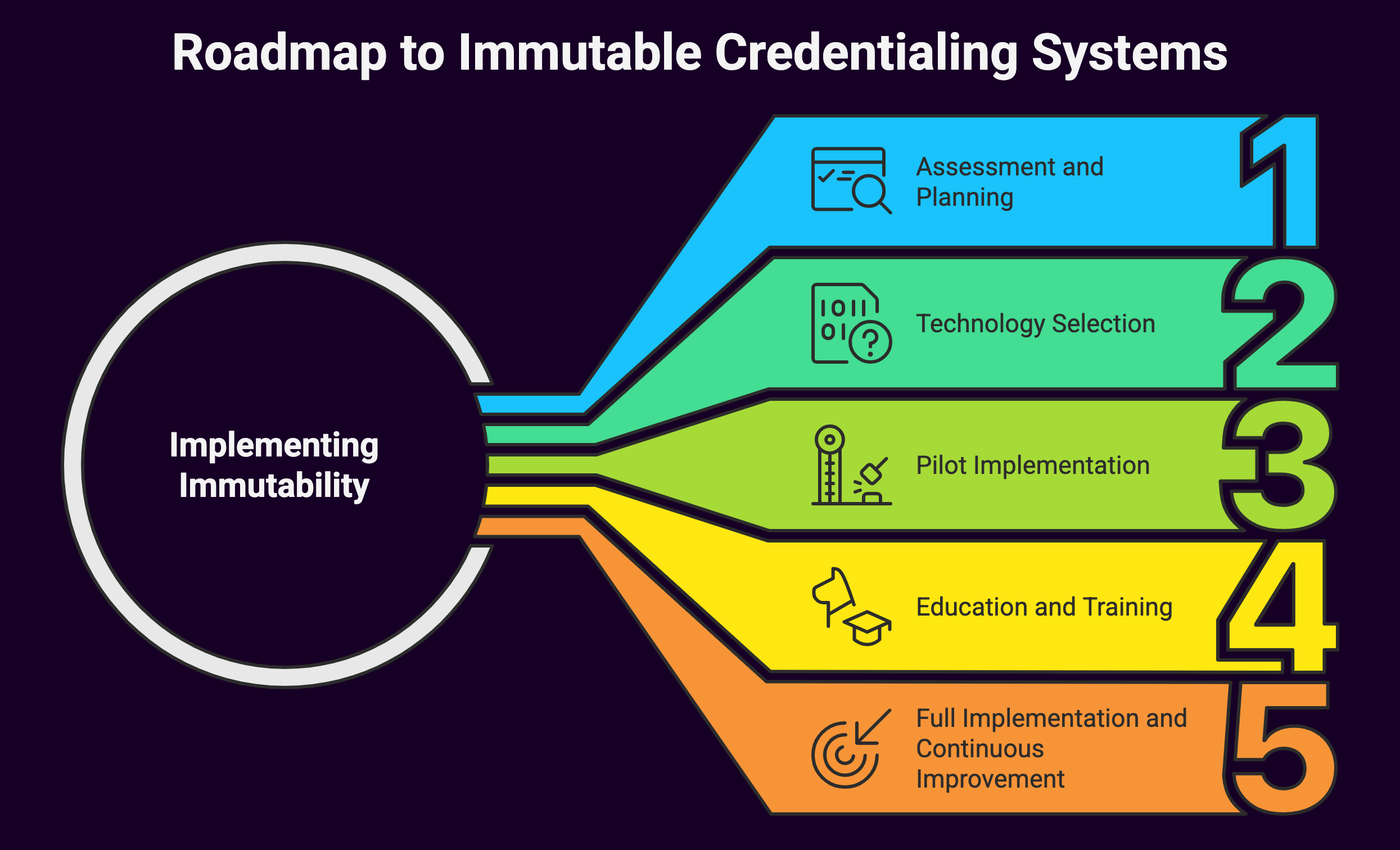Picture this: A healthcare organization needs to verify a physician’s credentials before allowing them to treat patients. The stakes are incredibly high as patient safety, organizational liability, and regulatory compliance all hang in the balance. In this critical process, how can we ensure the information being reviewed hasn’t been tampered with or altered?
 Enter the concept of immutability in provider credentialing.
Enter the concept of immutability in provider credentialing.
The healthcare ecosystem is becoming ever more digital. The integrity of information has never been more important. When we talk about “immutability,” we’re referring to a property where data, once recorded, cannot be altered, deleted, or manipulated. It creates a permanent, unalterable record. Similar to writing in permanent ink rather than pencil.
The undermentioned content shows how immutability is transforming provider credentialing, why it matters, and what healthcare organizations need to know to leverage this powerful concept in their operations.
The Credentialing Challenge: Why Traditional Methods Fall Short
Credentialing is notoriously complex and time-consuming.
The traditional process involves collecting, verifying, and monitoring a provider’s qualifications, including:
- Education and training
- Licensure and certifications
- Work history
- Malpractice claims history
- Board certifications
- Hospital privileges
- References and peer recommendations
Traditionally, these processes relied heavily on paper documentation, manual verification, and decentralized record-keeping.
Even as digital systems were introduced, they often created siloed databases that lacked transparency and suffered from several key problems:
- Data Inconsistency: Information about the same provider could vary across different systems, leading to confusion and potentially dangerous discrepancies.
- Tampering Vulnerability: Traditional databases could be modified, sometimes without adequate tracking of changes, creating opportunities for fraud or errors.
- Verification Redundancy: Each organization typically performed its own verification process, duplicating efforts across the healthcare system.
- Audit Trail Weaknesses: When changes were made to credentials data, the history of those changes might not be properly preserved, making it difficult to establish accountability.
What Is Immutability and Why Does It Matter in Healthcare?
At its core, immutability means “unable to be changed.” In database and information technology terms, an immutable record is one that, once created, cannot be deleted or altered, only appended to with new information.
Think of it like carving information into stone rather than writing it on a whiteboard. Once the chisel has done its work, that record remains permanently.
In healthcare credentialing, immutability delivers several critical benefits:
- Tamper-Proof Records: When credential information cannot be altered retroactively, the risk of fraud diminishes dramatically.
- Single Source of Truth: Immutable records can serve as the definitive version of a provider’s credentials, eliminating conflicts between different versions of the same information.
- Complete Audit Trails: Every credential verification, update, or addition is permanently recorded, creating a comprehensive history that can be reviewed if questions arise.
- Regulatory Compliance: Immutability helps organizations meet increasingly stringent requirements for data integrity in healthcare.
Technologies Enabling Immutability in Credentialing
Several technologies have emerged to enable truly immutable credentialing systems:
Blockchain Technology
Blockchain: the distributed ledger technology that underlies cryptocurrencies like Bitcoin, has found a natural application in healthcare credentialing.
Its key features make it particularly well-suited for this purpose:
- Distributed Nature: Information is stored across multiple nodes rather than in a central database, making it extremely difficult to tamper with records.
- Cryptographic Security: Each “block” of information is linked to the previous one through cryptographic hashes, creating a chain that would be computationally impossible to alter without detection.
- Consensus Mechanisms: Changes to the records require agreement from multiple participants in the network, adding another layer of security.
Several healthcare organizations have begun implementing blockchain-based credentialing systems. These platforms allow providers to create a secure digital wallet containing verified credentials that can be shared with hospitals, insurance companies, and other stakeholders without requiring repeated verification.
Content-Addressable Storage
Another approach to immutability involves content-addressable storage systems, where data is retrieved based on its content rather than its location.
Examples include:
- IPFS (InterPlanetary File System): A peer-to-peer hypermedia protocol designed to make the web faster, safer, and more open by addressing content by what it is rather than where it is.
- Merkle Trees: Data structures that enable efficient and secure verification of content in large data sets.
Digital Signatures and Timestamping
Digital signature technology creates cryptographic seals that verify both the authenticity of a document and ensure it hasn’t been altered since signing.
When combined with trusted timestamping services, these technologies provide powerful tools for creating verifiable, immutable credentials:
- PKI (Public Key Infrastructure): Provides the framework for creating, managing, and validating digital certificates.
- Trusted Timestamping: Adds a verifiable time element to digital signatures, proving when a document was created or certified.
Implementing Immutability in Provider Credentialing Workflows
Making the transition to immutable credentialing systems requires careful planning and implementation.

Here’s a roadmap for organizations looking to enhance their credentialing with immutability:
1. Assessment and Planning
Start by evaluating your current credentialing processes, identifying vulnerabilities, and determining which aspects would benefit most from immutability:
- Which parts of your credentialing process are most vulnerable to errors or fraud?
- What regulatory requirements must your immutable system satisfy?
- Which stakeholders need to be involved in the transition?
- What level of technical expertise exists within your organization?
2. Technology Selection
Based on your assessment, select the appropriate technologies for implementing immutability.
Consider factors such as:
- Scale of your operation
- Integration requirements with existing systems
- Budget constraints
- In-house technical capabilities
- Vendor options and their track records
3. Pilot Implementation
Before rolling out an immutable credentialing system organization-wide, conduct a pilot implementation:
- Select a small group of providers for initial implementation
- Define clear metrics for success
- Document challenges and solutions
- Gather feedback from all users
4. Education and Training
Immutable systems often represent a significant change in workflow and thinking.
Comprehensive training is essential:
- Provide role-specific training for all staff involved in credentialing
- Emphasize both the technical aspects and the underlying reasons for the change
- Create accessible reference materials and support resources
5. Full Implementation and Continuous Improvement
Once the pilot phase is complete and training is underway, proceed with full implementation:
- Establish a phased rollout schedule
- Create a dedicated support team during transition
- Implement regular audits to ensure the system is functioning as intended
- Develop processes for continuous improvement
Real-World Benefits: The Impact of Immutable Credentialing
Organizations that have implemented immutable credentialing systems report several significant benefits:
Accelerated Credentialing Timelines
With immutable, verified credentials that can be trusted across organizations, the time required for credentialing drops dramatically. One hospital network reported reducing their credentialing time from an average of 120 days to just 15 days after implementing an immutable credentialing system.
Reduced Administrative Costs
The efficiency gains from immutable credentialing translate directly into cost savings. A study of five healthcare organizations that implemented blockchain-based credentialing found an average 62% reduction in administrative costs associated with credentialing.
These savings come from:
- Reduced staff time spent on verification
- Lower costs associated with credential-related errors
- Decreased expenses related to maintaining multiple credentialing systems
Enhanced Regulatory Compliance
Immutable credentialing systems create automatic, tamper-proof audit trails that simplify regulatory compliance. Organizations report smoother accreditation processes and fewer findings during regulatory audits.
Improved Provider Experience
Providers benefit significantly from immutable credentialing systems. Instead of repeatedly submitting the same documents to different organizations, they can maintain verified credentials in a secure digital wallet that they control and share as needed.
Challenges and Considerations
While the benefits are compelling, implementing immutable credentialing isn’t without challenges:
Technical Complexity
Truly immutable systems, particularly those based on blockchain, require specialized technical expertise that may not exist within many healthcare organizations. This often necessitates partnerships with technology vendors or consultants.
Integration with Legacy Systems
Most healthcare organizations have existing credentialing systems that contain years of historical data. Integrating these with new immutable platforms requires careful planning and execution.
Cost Considerations
Implementing immutable credentialing systems requires upfront investment in technology, training, and process redesign. Organizations need to carefully calculate the return on investment timeframe.
Privacy and Data Governance
Immutable records raise important questions about data ownership, access control, and the right to be forgotten.
Organizations need clear policies governing:
- Who can access credential information
- How providers control their own data
- What happens when incorrect information is entered
- How to handle credential information for providers who leave the organization
The Future of Immutable Credentialing
As technology evolves and adoption increases, several trends are likely to shape the future of immutable credentialing:
Interoperability Standards
The development of common standards for credential data exchange between immutable systems will accelerate adoption and increase utility. Industry groups are already working on standardized formats and protocols to enable seamless sharing of verified credentials across platforms.
AI-Enhanced Verification
Artificial intelligence is beginning to play a role in credential verification, with systems that can intelligently cross-reference information from multiple sources and flag potential discrepancies for human review. When combined with immutable record-keeping, this creates a powerful framework for credential integrity.
Self-Sovereign Identity
The concept of self-sovereign identity, where providers maintain control of their own verified digital credentials and selectively share them with requesting organizations, is gaining traction. This approach puts providers at the center of the credentialing process while maintaining the security and verifiability that organizations require.
Summary: The Imperative for Immutability
Healthcare is growing more complex and interconnected. The need for trustworthy credential information becomes ever more critical. Immutable credentialing offers a path forward that addresses many of the longstanding challenges in this critical function.
For healthcare organizations, the question is increasingly not whether to implement immutable credentialing, but how and when. Those who move proactively to adopt these technologies stand to gain significant advantages in efficiency, compliance, and provider satisfaction.
The foundations of healthcare, which are trust, safety, and quality depend on knowing with certainty that providers have the qualifications they claim. Immutable credentialing provides that certainty in a way that traditional systems simply cannot match.

